
Hoodening, also spelled hodening and oodening, is a folk custom found in Kent, a county in South East England. The tradition entails the use of a wooden hobby horse known as a hooden horse that is mounted on a pole and carried by a person hidden under a sackcloth. Originally, the tradition was restricted to the area of East Kent, although in the twentieth century it spread into neighbouring West Kent. It represents a regional variation of a "hooded animal" tradition that appears in various forms throughout Britain and Ireland.
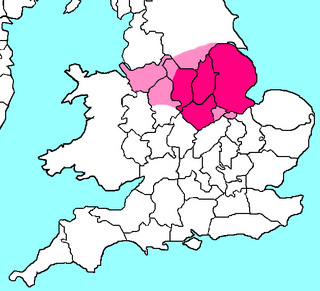
The North Midlands is a loosely defined area covering the northern parts of the Midlands in England. It is not one of the ITL regions like the East Midlands or the West Midlands.

Golowan is the Cornish language word for the Midsummer celebrations in Cornwall, UK; widespread prior to the late 19th century and most popular in the Penwith area and in particular Penzance and Newlyn. The celebrations were centred on the lighting of bonfires and fireworks and the performance of associated rituals. The midsummer bonfire ceremonies were revived at St Ives in 1929 by the Old Cornwall Society and since then spread to other societies across Cornwall, as far as Kit Hill near Callington. Since 1991 the Golowan festival in Penzance has revived many of these ancient customs and has grown to become a major arts and culture festival; its central event Mazey Day now attracts tens of thousands of people to the Penzance area in late June.

Pointed hats have been a distinctive item of headgear of a wide range of cultures throughout history. Although often suggesting an ancient Indo-European tradition, they were also traditionally worn by women of Lapland, the Japanese, the Mi'kmaq people of Atlantic Canada, and the Huastecs of Veracruz and Aztec. The Kabiri of New Guinea have the diba, a pointed hat glued together.

The Mari Lwyd is a wassailing folk custom found in South Wales. The tradition entails the use of an eponymous hobby horse which is made from a horse's skull mounted on a pole and carried by an individual hidden under a sheet.
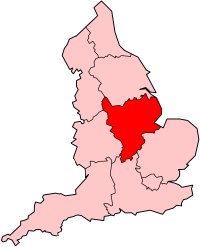
East Midlands English is a dialect, including local and social variations spoken in most parts of East Midlands England. It generally includes areas east of Watling Street, north of an isogloss separating it from variants of Southern English and East Anglian English, and south of another separating it from Northern English dialects. This includes the counties of Derbyshire, Leicestershire, Lincolnshire, Nottinghamshire, Rutland and Northamptonshire. Dialects of northern Derbyshire, Nottinghamshire and Lincolnshire usually share similarities with Northern English dialects. Relative to other English dialects, there have been relatively few studies of East Midlands English.
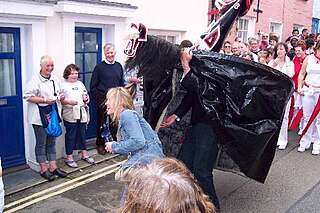
The 'Obby 'Oss festival is a folk custom that takes place each 1st of May in Padstow, a coastal town in North Cornwall. It involves two separate processions making their way around the town, each containing an eponymous hobby horse known as the 'Obby 'Oss.

In the coastal town of Minehead, located in the southwest English county of Somerset, there is a folk custom on May Day entailing the parading of a brightly decorated hobby horse around the locality.

A soul cake, also known as a soulmass-cake, is a small round cake which is traditionally made for Halloween, All Saints' Day and All Souls' Day to commemorate the dead in many Christian traditions. The cakes, often simply referred to as souls, are given out to soulers who go from door to door during the days of Allhallowtide singing and saying prayers "for the souls of the givers and their friends", especially the souls of deceased relatives, thought to be in Purgatory. The practice in England dates to the medieval period, and was continued there until the 1930s. In Sheffield and Cheshire, the custom has continued into modern times. In Lancashire and in the North-east of England soul cakes were known as Harcakes, a kind of thin parkin.

"The Derby Ram" or "As I was Going to Derby" is a traditional tall tale English folk song that tells the story of a ram of gargantuan proportions and the difficulties involved in butchering, tanning, and otherwise processing its carcass.

The Dorset Ooser is a wooden head that featured in the 19th-century folk culture of Melbury Osmond, a village in the southwestern English county of Dorset. The head was hollow, thus perhaps serving as a mask, and included a humanoid face with horns, a beard, and a hinged jaw which allowed the mouth to open and close. Although sometimes used to scare people during practical jokes, its main recorded purpose was as part of a local variant of the charivari custom known as "skimity riding" or "rough music", in which it was used to humiliate those who were deemed to have behaved in an immoral manner.

In folklore, a hobby horse is a costumed character that features in some traditional seasonal customs, processions and similar observances around the world. In England, they are particularly associated with May Day celebrations, mummers' plays and the Morris dance.
The Winster Guisers are a group who perform a traditional mummers play in and around the village of Winster, Derbyshire, UK, during the Christmas season. Their performance is based on a photograph taken c. 1870 outside Winster Hall showing an unidentified set of performers about whom little is known for certain. The Winster Guisers' play is not local to the area, but is a revival of a Cheshire play, chosen because it features a hobby horse similar to the one in the centre of the old photograph. A "guiser" is someone in disguise, though in the Winster area the term was widely used for the teams of Christmas mummers.
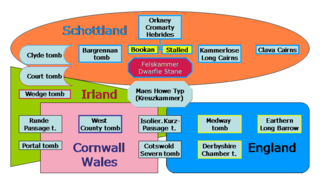
British megalith architecture is the study of those ancient cultures that built megalithic sites on the British Isles, including the research and documentation of these sites. The classification sometimes used of these cultures based on geological criteria is problematic.

Old Tup, sometimes termed the Derby Tup or the Derby Ram, is a folk custom found in an area of the East Midlands of England. Geographically, the custom was found on the borders of Derbyshire and Yorkshire and stretched into part of Nottinghamshire. The tradition entails the use of a hobby horse with a goat's head that is mounted on a pole and carried by an individual hidden under a sackcloth. It represents a regional variation of a "hooded animal" tradition that appears in various forms throughout the British Isles. In geographical location and style it displays strong similarities with the Old Horse custom, but in the latter the hobby horse was presented as a horse rather than a ram.
Old Ball is a folk custom that existed in the Forest of Rossendale in Lancashire, north-western England during the nineteenth century. The tradition entailed the use of a hobby horse that is mounted on a pole and carried by an individual hidden under a sackcloth. It represents a regional variation of a "hooded animal" tradition that appears in various forms throughout the UK.
The Broad was a folk custom found in the Cotswolds, an area of south-central England, during the nineteenth and early twentieth centuries. The tradition entails the use of a hobby horse with a bull's head that is mounted on a pole and carried by an individual hidden under a sackcloth. It represents a regional variation of a "hooded animal" tradition that appears in various forms throughout the British Isles.
Láir Bhán is a hobby horse that was part of a folk custom found in parts of Ireland, particularly in the area of County Kerry, in the eighteenth and nineteenth centuries.
The Wooing Play was a form of performance found in the folk culture of parts of east-central England.
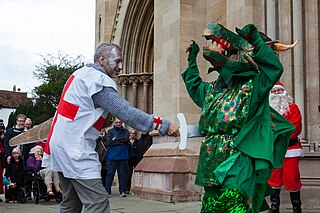
Mummers' plays are folk plays performed by troupes of amateur actors, traditionally all male, known as mummers or guisers. Historically, mummers' plays consisted of informal groups of costumed community members that visited from house to house on various holidays. Today the term refers especially to a play in which a number of characters are called on stage, two of whom engage in a combat, the loser being revived by a doctor character. This play is sometimes found associated with a sword dance though both also exist in Britain independently.















